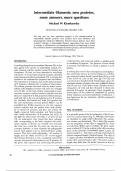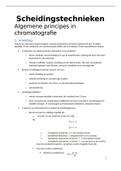Tentamen (uitwerkingen)
Intermediate filaments: new proteins, some answers, more questions
- Vak
- Instelling
A second group, the neuronal clFps, are related more in terms of intron/exon structure than primary se- quence. This group contains the rather divergent clF proteins NF1, NFm, NFh, 0t-internexin and nestin. It appears that these proteins can all co-polymerize with vimentin and, from the p...
[Meer zien]





